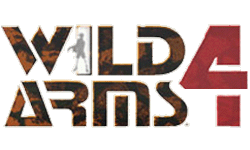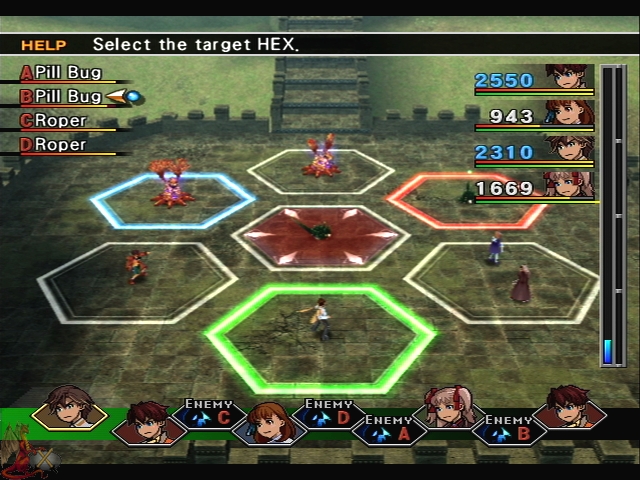|
|

|
BATTLE SYSTEM
|

|
INTERACTION
|

|
ORIGINALITY
|

|
STORY
|

|
MUSIC & SOUND
|

|
VISUALS
|

|
CHALLENGE
|
Mostly easy
|
COMPLETION TIME
|
30-50 hours
|
|
OVERALL
4.5/5
|
Rating definitions
|
|
|
When I started playing this new installment in the Wild ARMs series, it didn't take me long to realize that I was in for something different. Yes, I was still in Filgaia, but this game is a significant departure from its predecessors in most respects. This turns out to be a good thing, as Wild ARMs 4 disposes of a slew of stale or less-than-stellar ideas from earlier Wild ARMs titles, replacing them with new fresh ideas. The result of this dramatic shift is one of the most enjoyable RPGs I've played in years.
The battle system is the high point of the game, and this comes from someone who tends to glaze over random battles in most games. In fact, throughout most of the game, I wore the Bad Omen badge which increases the encounter rate. Even though I occasionally ended up having a battle every few steps at times, I was very rarely tempted to remove the badge and I only used the ability to turn off encounters a few times toward the end. This ability to turn off encounters is one of the departures from earlier Wild ARMs titles, which used Migrant Badges and an encounter cancel system to allow you to avoid encounters as long as you had enough points in your encounter gauge. In this game, you gain the ability to turn encounters on and off with the press of a button when you purify the dungeon's "break point," or save point. Sometimes this involves fighting a special battle at this break point, and other times it means solving a puzzle or satisfying some condition inside the dungeon.
Battles themselves occur in a large hexagon made up of seven smaller hexes. What makes the system interesting is that attacks and most status effects apply to the hex, not to characters. Since multiple characters and multiple enemies can be a single hex, this means that a single attack can, and usually does, hit everyone on that hex. Your characters and the enemies can't share a hex, naturally. This creates a system that has something of the feel of a tactical RPG, but instead of battles lasting twenty minutes, most are resolved within a minute or two. Indeed, despite using a turn-based system, the battles still tend to have a feel of being lightning-quick. This is another area where it departs from previous Wild ARMs titles, as the other games in the series used rounds where you entered commands for every character before any action occurred. In this game, the characters execute the action immediately.
Much of the speed of the battles also comes from the unusual way in which character statistics increase, especially hit points. I was surprised to find at the beginning of the game that Jude had over 2,000 HP, and I ended the game having less than 6,000. It would have been less if I'd made extensive use of the Growth Customization system, which allows you to give up HP and MP in order to use abilities you haven't reached the necessary level to master. Most enemy attacks throughout the game inflict over 1,000 points of damage. HP is restored after every battle, but during the battle, you tend to take heavy damage. This is countered by the fact that you can kill most enemies in one or two hits, and if they group up on a hex, then you can easily kill many at once. Even boss battles tend to be resolved quickly because of the massive level of damage that can be inflicted on each attack. This is a bit of a flaw, as the boss battles are often over by the time you start to really enjoy them.
The soundtrack of the game is quite good despite the lack of Michiko Naruke, the composer who created the music for the previous Wild ARMs titles. Still, the music in this game is less distinctive and has generally less of the western feel present in the soundtracks of the previous titles, but it doesn't get old or feel painfully repetitive. I often found myself humming along with the battle themes as well. There really isn't anything special about the visuals in the game, aside from the unique presentation of dialogue sequences. I wouldn't categorize the graphics as bad, but simply as average quality, though there are some neat graphical effects in some areas. The graphics do nothing to take away from the experience, though, and thus, the fact that they aren't stunning isn't a problem.
 There may be hexes in battles, but there's no hex on them.
There may be hexes in battles, but there's no hex on them.
|
|
The game is generally quite easy, but the difficulty of battles is slightly randomized due to random placement of your characters and the enemies in hexes at the beginning of battles. You may find the occasional battle to be quite difficult due to your characters being cornered in a single hex, though this becomes less of a issue later in the game due to the Isolate ability which allows you to randomly distribute your characters among empty hexes. Additionally, running into the occasional rare enemy may leave one between a rock and a hard place. Most often, though, battles are very easy, if perhaps too easy. Of course, with my increased encounter rate, I was quite likely overleveled.
Another departure from earlier Wild ARMs titles is the nature of the puzzles and the way you move through dungeons. Wild ARMs 4 disposes of the idea of each character having their own set of tools; instead, if you need tools to solve puzzles, you will find them in the dungeons themselves. Also, the game has a platforming element to it, with the ability to double jump (you can jump once in midair), stomp dive on switches, and slide through small spaces. The game evens includes "side view" areas that work like side-scrolling platformers, and one of the optional minigames really is a side-scrolling platformer. Most of the platforming element is easy enough to get through, though some areas will require a few attempts in order to proceed forward. In addition, with necessary tools in the dungeons and the inability to jump while holding a tool, there is the occasional annoying need to backtrack to retrieve a tool upon discovering it's needed (or still needed, in some cases).
There are a few grammatical errors in the game, and you may also notice a few instances of text running off the screen. Additionally, one of the first original commands available for Jude is missing the first letter in its name, though the game offers the ability to rename these commands, so at least this can be fixed. The interface works well enough, but the fact that the main commands are organized into hexes the same way the battle hexes are laid out creates a minor problem. This encourages the use of the analog stick for selecting the commands, and it is a tad oversensitive, resulting in selecting the wrong command at times. Despite this, the game's interface functions well enough without being too obtrusive.
 Here, we cut to a cutscene that cuts the screen.
Here, we cut to a cutscene that cuts the screen.
|
|
The story of Wild ARMs 4 is a mixed blessing. The presentation of most dialogue sequences is done in an unusual way with character portraits displayed with lines separating them, and they move around the screen during conversations. With this unusual means of presentation, it seems they were able to insert more dialogue into the game. You may notice the presence of a great deal of three-area dungeons where a conversation occurs on each transition between the areas. While this is good in that it creates more opportunity to develop the characters and flesh out the plot, it also seemed to create a compulsion to have conversation that lacked any real purpose. Thus, there is a lot of feeling of repetition in dialogue and it often leaves you with unfinished conversations, waiting for you to progress to the next area of a dungeon before continuing it. Another flaw with this method of presentation is the limited variety of emotional expression, and in many cases, the choice of expression seems inappropriate or extremely exaggerated for what is being said.
The story also takes a long time to really get going. It starts with military forces entering the peaceful village of Ciel, which turns out to be in an artificial habitat over the war-torn devastated world on Filgaia. Jude Maverick, a young boy in this village, meets up with Arnaud and Yulie here before an accident with Jude using an ARM destroys the village. From this point on, the party spends much of its time fleeing the military forces of Brioniac with only vague hints being given as to the overall point of it all. Once a certain point is reached, though, the game starts revealing the overall plot very quickly and it becomes fairly easy to figure out what's about to happen, though there is an unexpected major plot twist in the later half. The game's story is interesting and enjoyable provided you can ignore the flaws in presentation and tolerate the repetitive conversations and drawn-out early half long enough to get to the good parts. Those are difficult to talk about without revealing spoilers. Most of the characters, including even the villains, are also interesting, even if they are sometimes a bit strange, and there is some level of painful sappiness and naivety on occasion, though some of this is appropriate for the ages of the characters.
Overall, Wild ARMs 4 is a superb game, if not quite as good as it could have been. It shows considerable promise for the Wild ARMs series by throwing out many poor ideas introduced in earlier Wild ARMs titles and introducing some good, innovative ones. The game benefits from a unique and immensely enjoyable battle system and a story that is pretty good despite flaws in presentation, repetitiveness in dialogue, and a slow start. It could have been a little more challenging, but any game that actually makes an increased encounter rate enjoyable has clearly done something right. Even if you can't enjoy the story due to its flaws, the battle system might just be enough to allow you to enjoy the experience anyway. All in all, it would be hard to play this game and not derive some fun from it along the way, so I highly recommend it to any RPGamer, especially anyone looking for something different.
Review Archives
|









